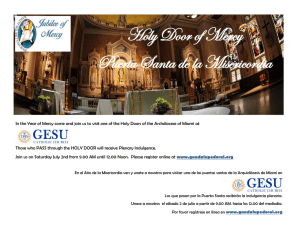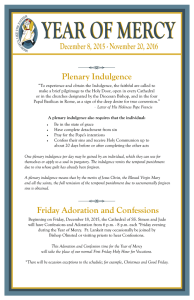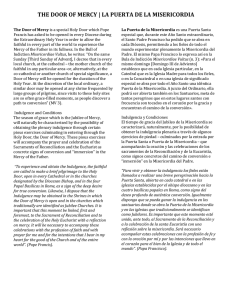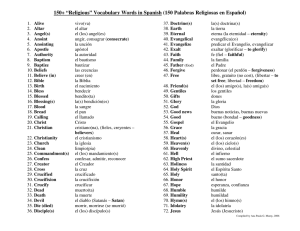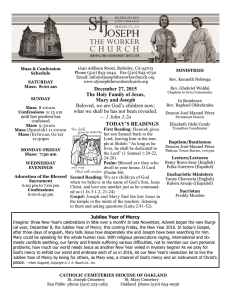Pilgrimage to cross the Holy Year Door Sunday, October 9, 2016
Anuncio
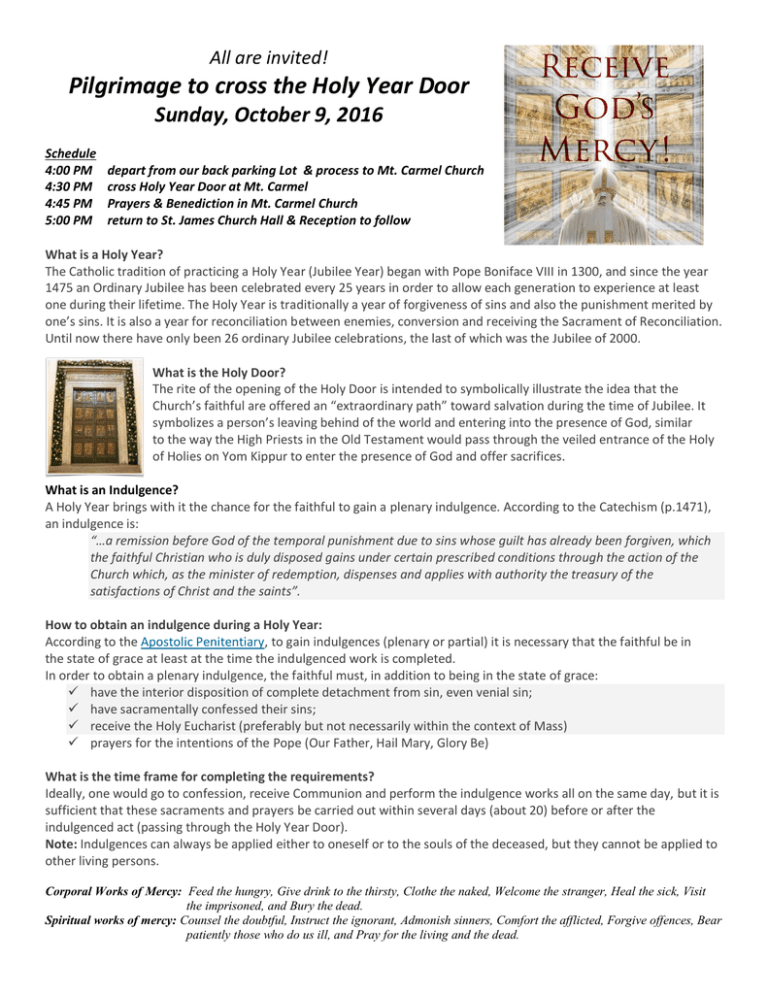
All are invited! Pilgrimage to cross the Holy Year Door Sunday, October 9, 2016 Schedule 4:00 PM 4:30 PM 4:45 PM 5:00 PM depart from our back parking Lot & process to Mt. Carmel Church cross Holy Year Door at Mt. Carmel Prayers & Benediction in Mt. Carmel Church return to St. James Church Hall & Reception to follow What is a Holy Year? The Catholic tradition of practicing a Holy Year (Jubilee Year) began with Pope Boniface VIII in 1300, and since the year 1475 an Ordinary Jubilee has been celebrated every 25 years in order to allow each generation to experience at least one during their lifetime. The Holy Year is traditionally a year of forgiveness of sins and also the punishment merited by one’s sins. It is also a year for reconciliation between enemies, conversion and receiving the Sacrament of Reconciliation. Until now there have only been 26 ordinary Jubilee celebrations, the last of which was the Jubilee of 2000. What is the Holy Door? The rite of the opening of the Holy Door is intended to symbolically illustrate the idea that the Church’s faithful are offered an “extraordinary path” toward salvation during the time of Jubilee. It symbolizes a person’s leaving behind of the world and entering into the presence of God, similar to the way the High Priests in the Old Testament would pass through the veiled entrance of the Holy of Holies on Yom Kippur to enter the presence of God and offer sacrifices. What is an Indulgence? A Holy Year brings with it the chance for the faithful to gain a plenary indulgence. According to the Catechism (p.1471), an indulgence is: “…a remission before God of the temporal punishment due to sins whose guilt has already been forgiven, which the faithful Christian who is duly disposed gains under certain prescribed conditions through the action of the Church which, as the minister of redemption, dispenses and applies with authority the treasury of the satisfactions of Christ and the saints”. How to obtain an indulgence during a Holy Year: According to the Apostolic Penitentiary, to gain indulgences (plenary or partial) it is necessary that the faithful be in the state of grace at least at the time the indulgenced work is completed. In order to obtain a plenary indulgence, the faithful must, in addition to being in the state of grace: have the interior disposition of complete detachment from sin, even venial sin; have sacramentally confessed their sins; receive the Holy Eucharist (preferably but not necessarily within the context of Mass) prayers for the intentions of the Pope (Our Father, Hail Mary, Glory Be) What is the time frame for completing the requirements? Ideally, one would go to confession, receive Communion and perform the indulgence works all on the same day, but it is sufficient that these sacraments and prayers be carried out within several days (about 20) before or after the indulgenced act (passing through the Holy Year Door). Note: Indulgences can always be applied either to oneself or to the souls of the deceased, but they cannot be applied to other living persons. Corporal Works of Mercy: Feed the hungry, Give drink to the thirsty, Clothe the naked, Welcome the stranger, Heal the sick, Visit the imprisoned, and Bury the dead. Spiritual works of mercy: Counsel the doubtful, Instruct the ignorant, Admonish sinners, Comfort the afflicted, Forgive offences, Bear patiently those who do us ill, and Pray for the living and the dead. !Todos están invitados! La Peregrinación para entrar la Puerta Santa Domingo, 9 octubre 2016 Horario 4:00 PM 4:30 PM 4:45 PM 5:00 PM Salir del parqueo atrás y caminar hacia Iglesia Monte Carmelo Cruzar el Umbral de la Puerta Santa de Monte Carmelo Oraciones y Benedición Regresar al Templo para un Compartir ¿Qué es un Año Santo? La tradición católica de celebrar un Año Jubilar comenzó con el Papa Bonifacio VIII en 1300, y desde 1475 cada 25 años se celebra un Jubileo ordinario para permitir que cada generación experimente este momento al menos una vez en la vida. El Año Jubilar es un año de perdón y penitencia por los pecados de cada uno. También es un año de reconciliación entre enemigos y conversión para recibir el Sacramento de la Reconciliación. Hasta ahora solo se han realizado 26 años jubilares ordinarios, la última fue el Jubileo del año 2000 convocado por San Juan Pablo II. ¿Qué es una Puerta Santa? El rito de la apertura de la Puerta Santa pretende ilustrar simbólicamente que a los fieles de la Iglesia se les ofrece un "camino extraordinario" hacia la salvación durante el tiempo del Jubileo. Simboliza el dejar atrás el mundo y entrar en la presencia de Dios, de manera similar a la forma en que los sumos sacerdotes del Antiguo Testamento atravesaban la entrada del santuario interior del Tabernáculo en Yom Kipur -la conmemoración judía del Día de la Expiación, perdón y del arrepentimiento de corazón- para entrar en la presencia de Dios y ofrecer sacrificios. ¿Qué es una indulgencia plenaria? Un Año Santo trae consigo la posibilidad de que los fieles puedan ganar la indulgencia plenaria. De acuerdo con el párrafo 1471 del Catecismo, una indulgencia es: "...la remisión ante Dios de la pena temporal por los pecados, ya perdonados, en cuanto a la culpa, que un fiel dispuesto y cumpliendo determinadas condiciones consigue por mediación de la Iglesia, la cual, como administradora de la redención, distribuye y aplica con autoridad el tesoro de las satisfacciones de Cristo y de los santos". ¿Cómo obtener una indulgencia durante un Año Santo? De acuerdo a la Penitenciaría Apostólica, para ganar indulgencias plenarias (o parciales), es necesario que los fieles estén en estado de gracia y además: Tengan la disposición interior de un desapego total del pecado, incluso venial; Confiesen sacramentalmente sus pecados; Reciban la Sagrada Eucaristía (preferiblemente, pero no necesariamente en el contexto de la Misa) Oren por las intenciones del Papa (Padre Nuestro, Ave María, Gloria) ¿Dentro de cuanto tiempo para cumplir los requisitos? Lo ideal sería ir a confesarse, recibir la comunión y realizar la indulgencia en el mismo día, pero es suficiente que estos sacramentos y oraciones se lleven a cabo dentro de varios días (alrededor de 20) antes o después del acto de indulgencia. Note: Las indulgencias siempre se pueden aplicar ya sea a uno mismo o por las almas de los difuntos, pero no pueden ser aplicados a otras personas vivas. Obras de misericordia corporales: Visitar a los enfermos, Dar de comer al hambriento, Dar de beber al sediento, Dar posada al peregrino, Vestir al desnudo, Visitar a los presos, Enterrar a los difuntos. Obras de misericordia espirituales: Enseñar al que no sabe, Dar buen consejo al que lo necesita, Corregir al que se equivoca, Perdonar al que nos ofende, Consolar al triste, Sufrir con paciencia los defectos del prójimo, Rezar a Dios por los vivos y por los difuntos.
